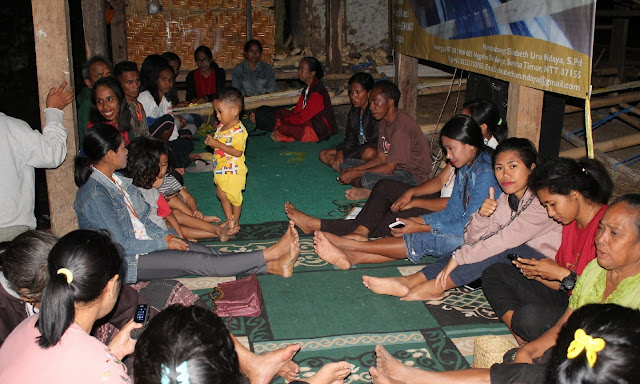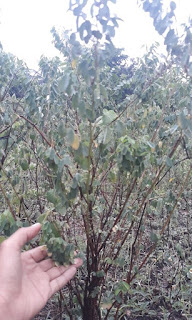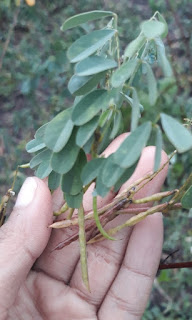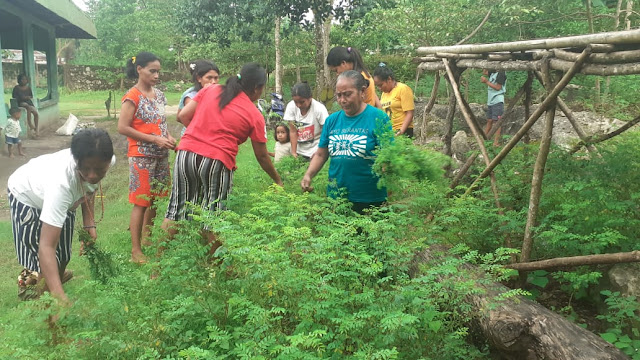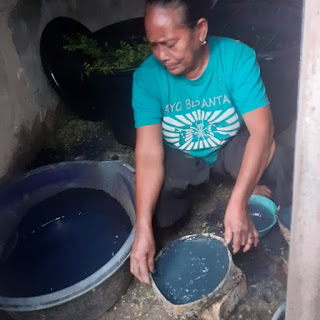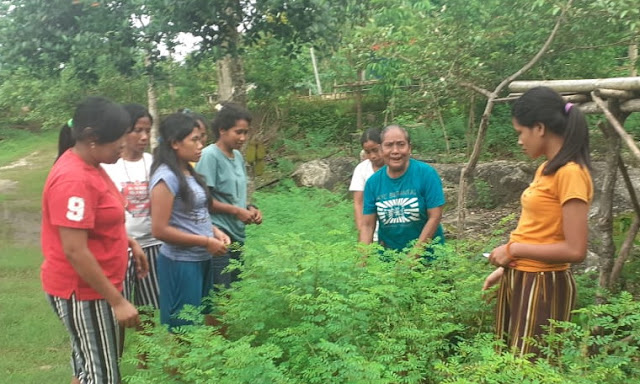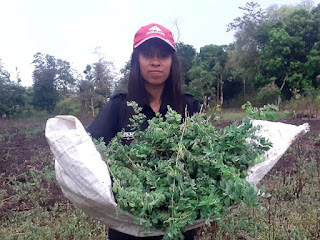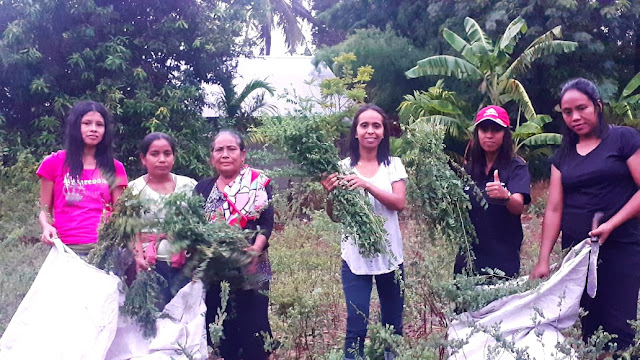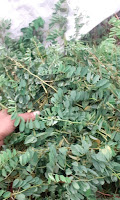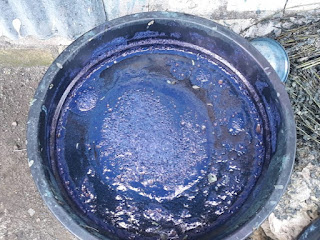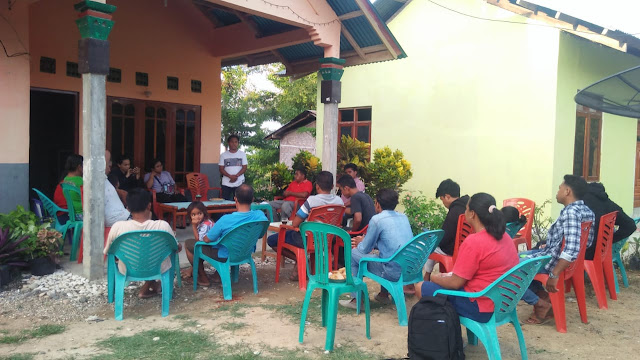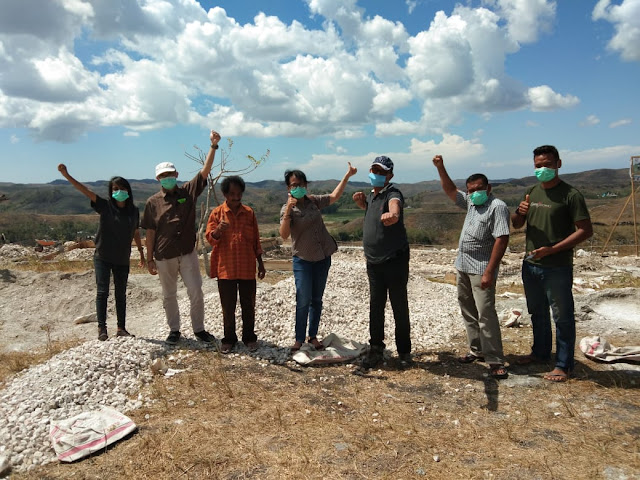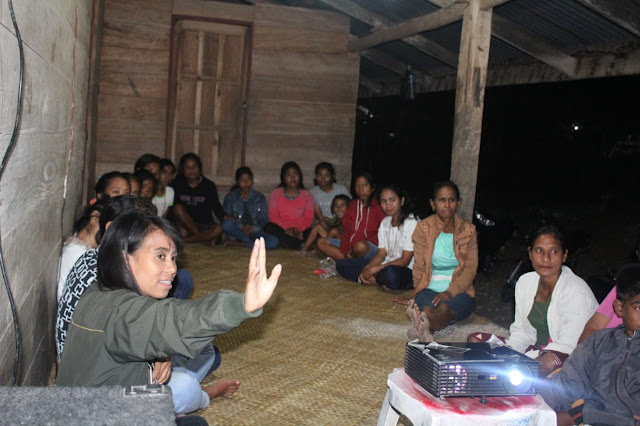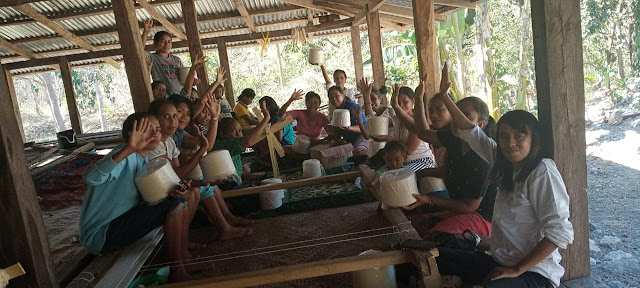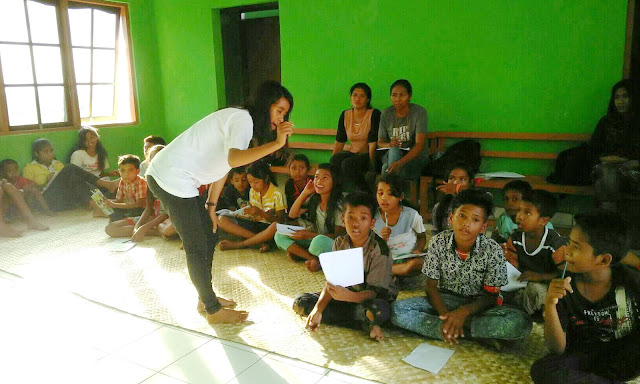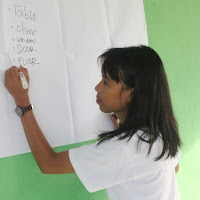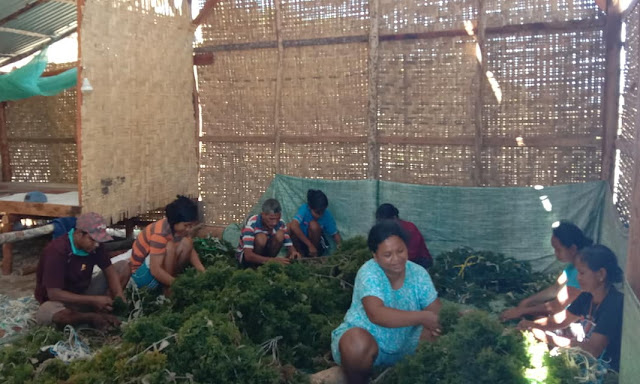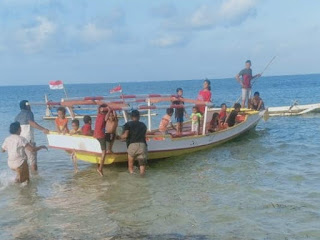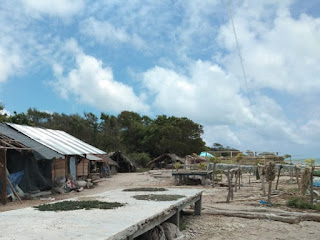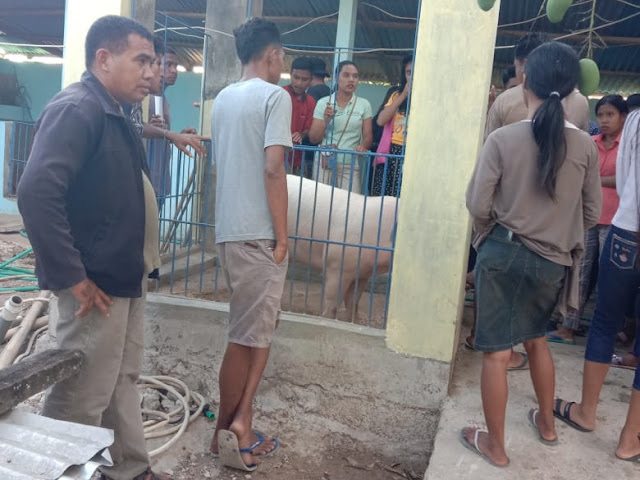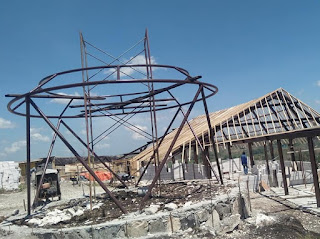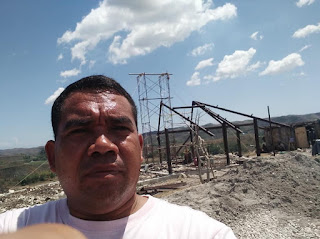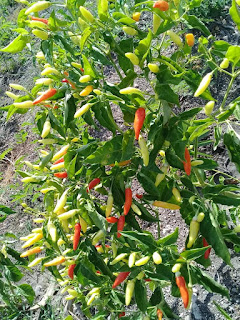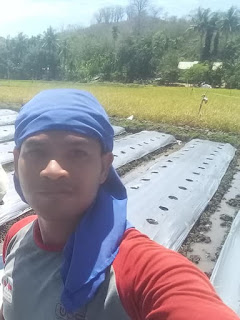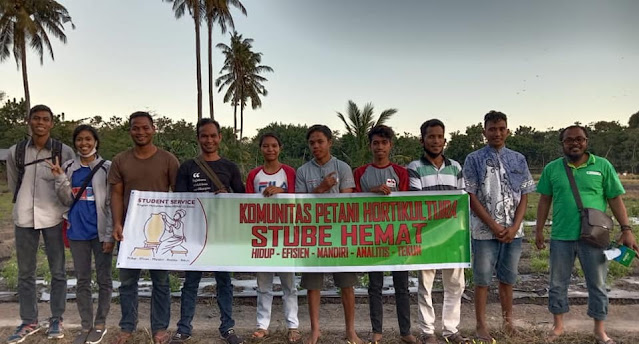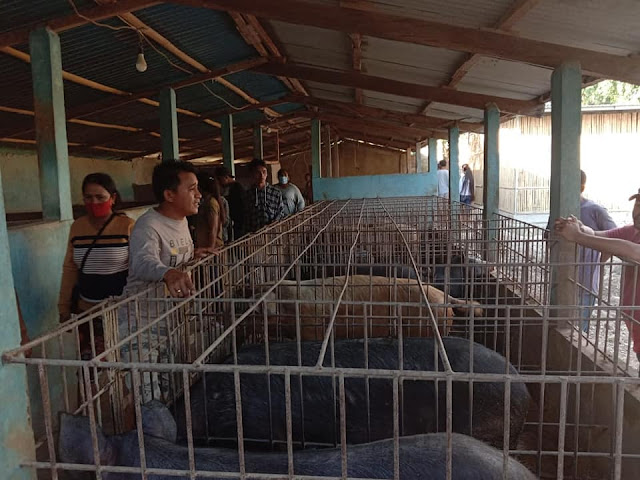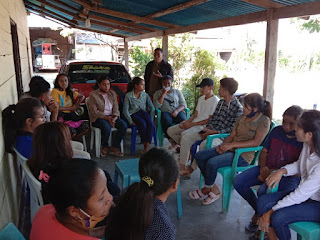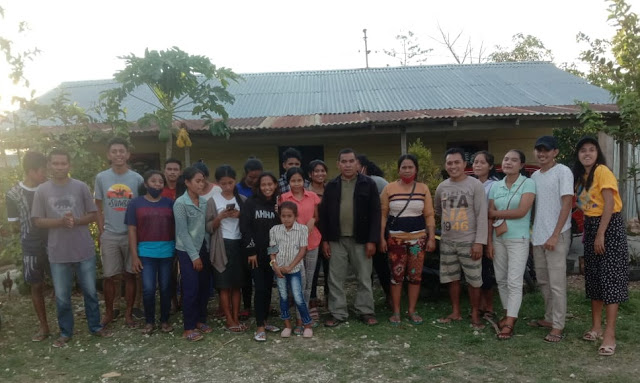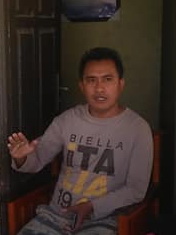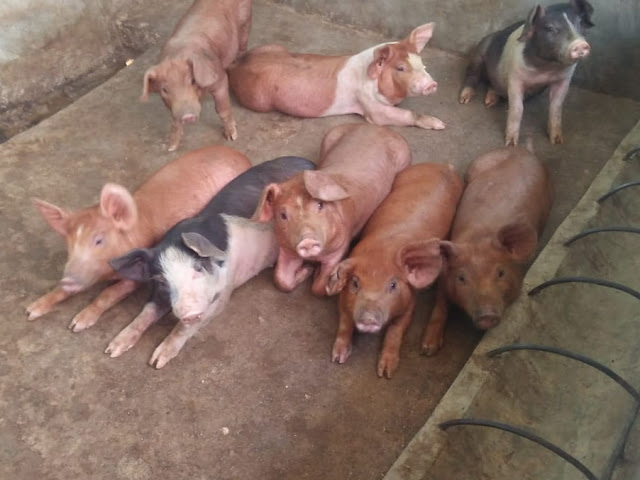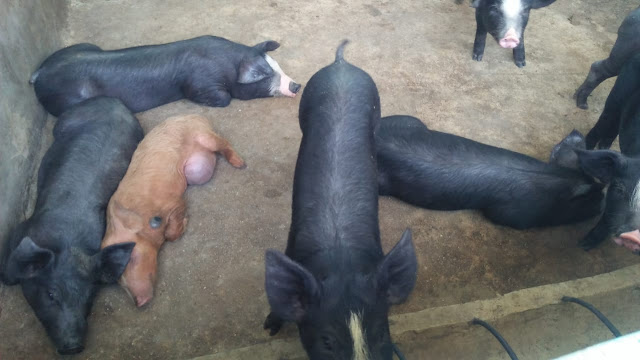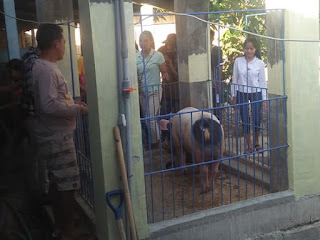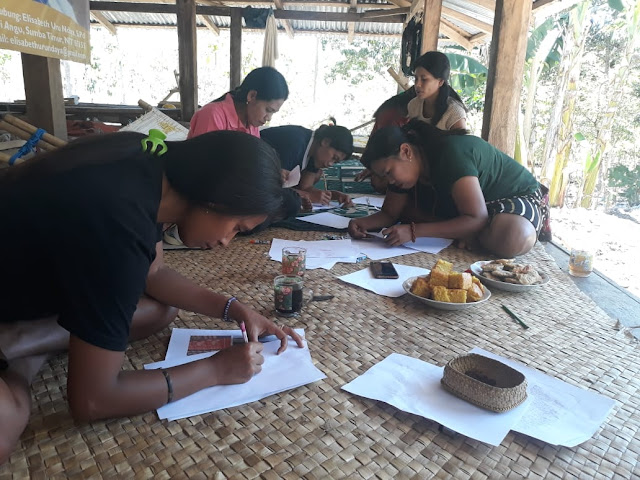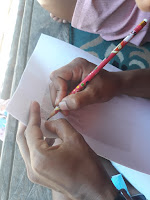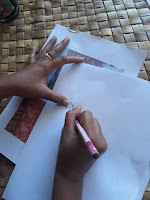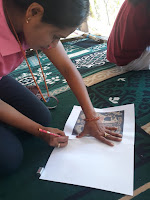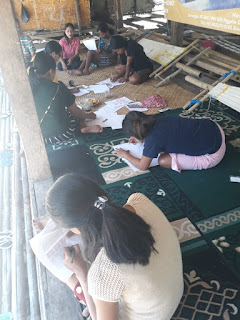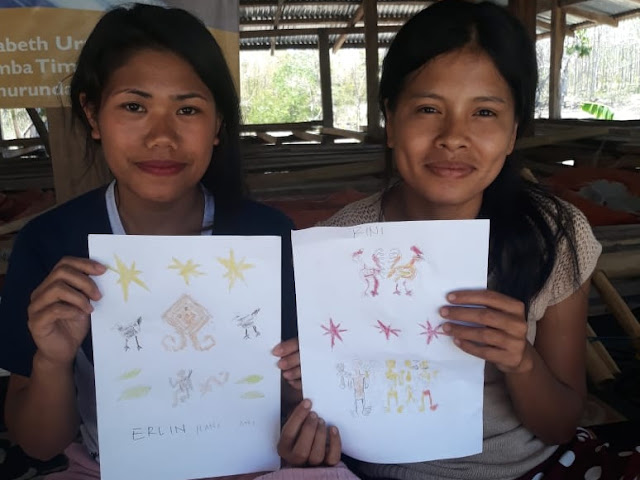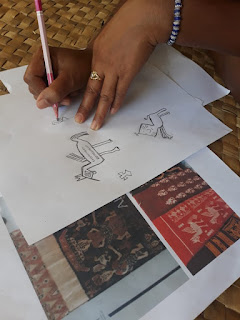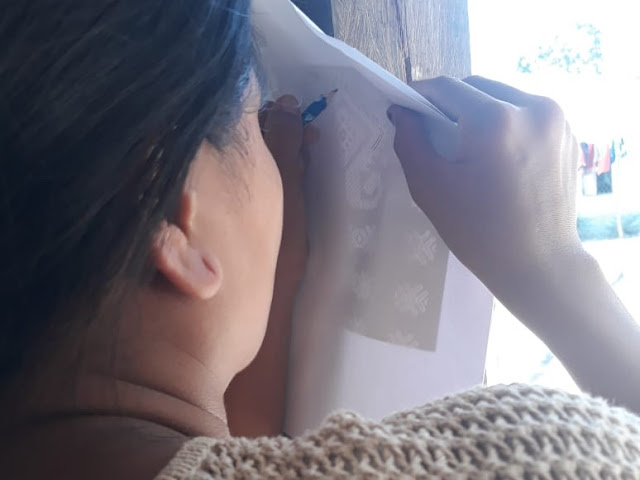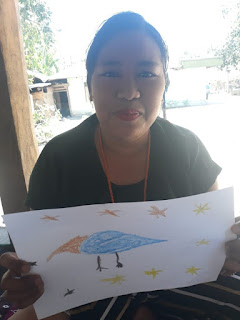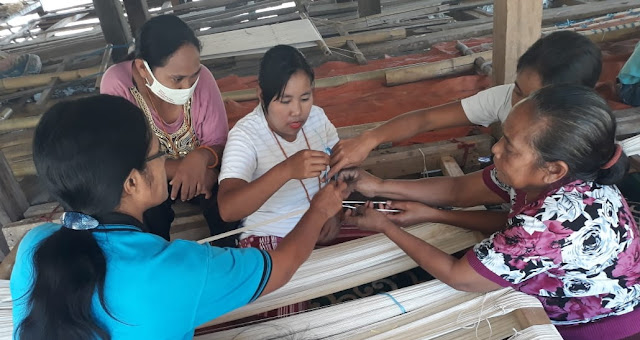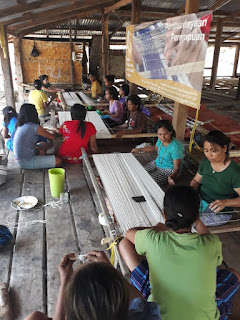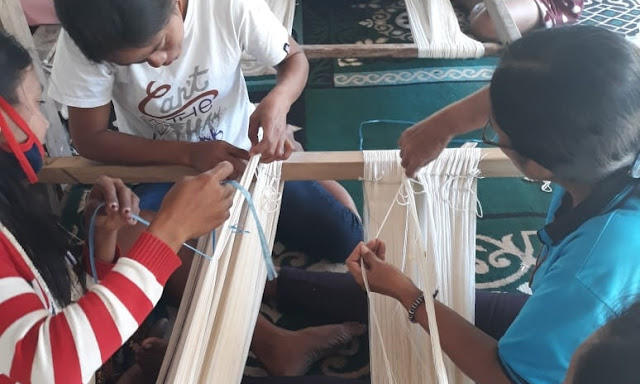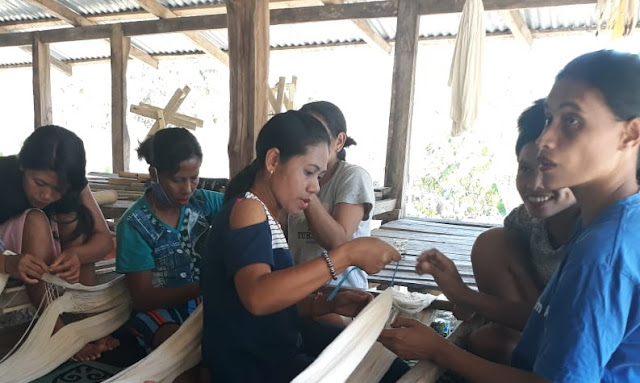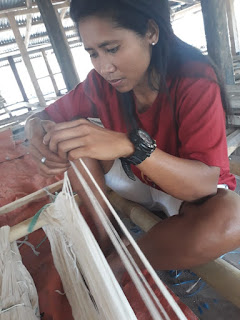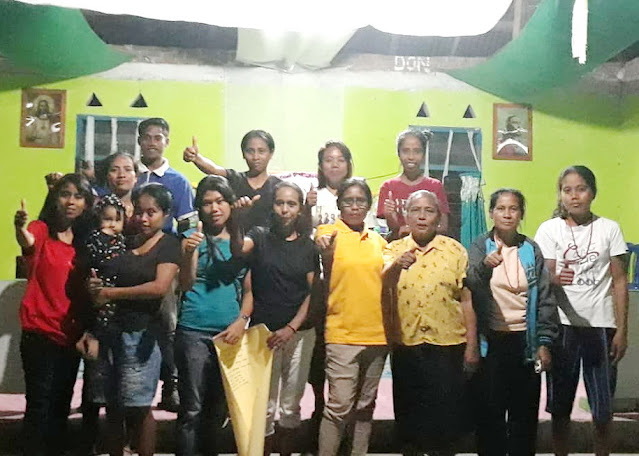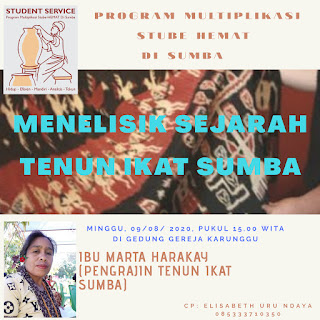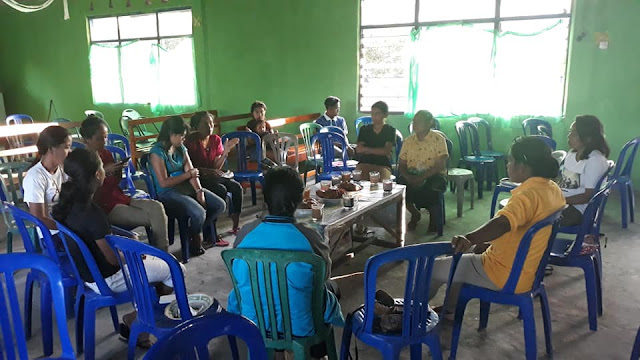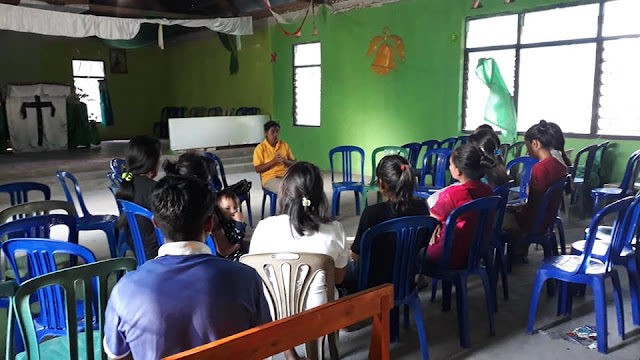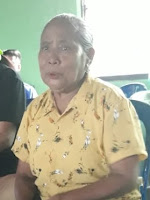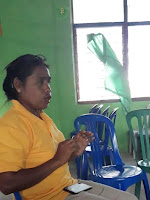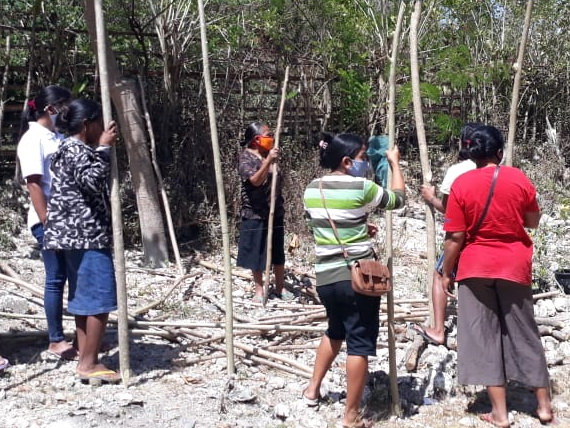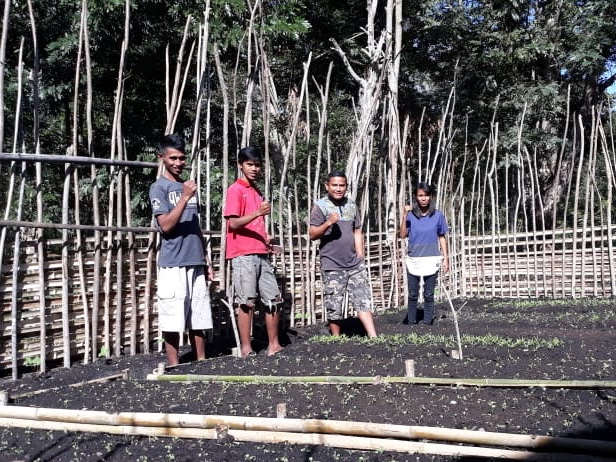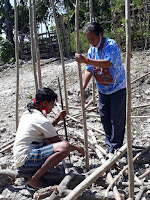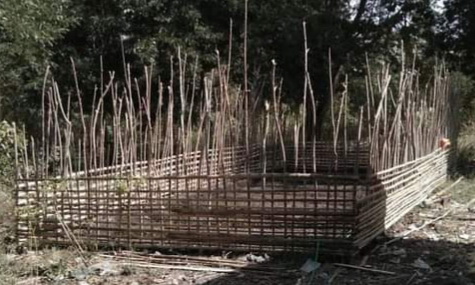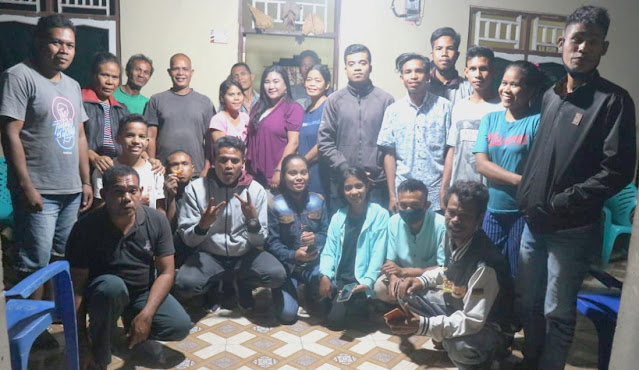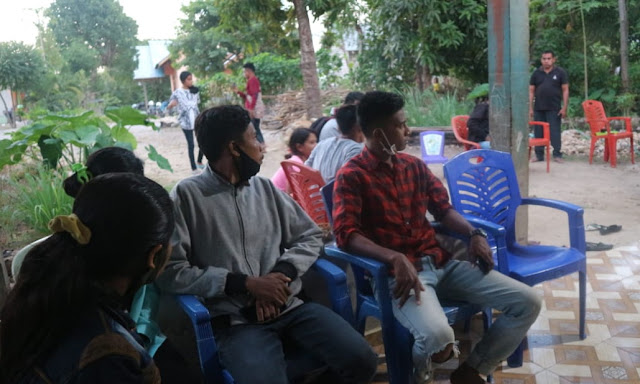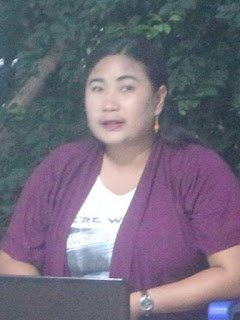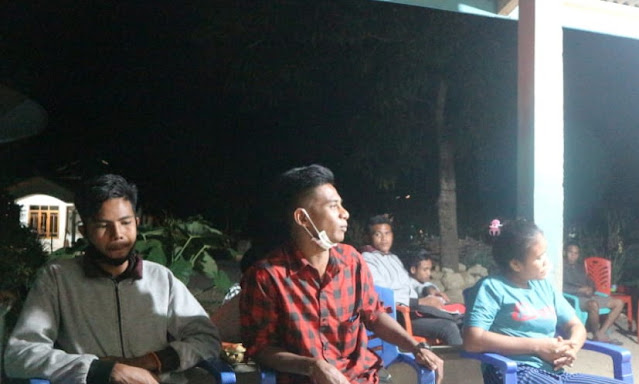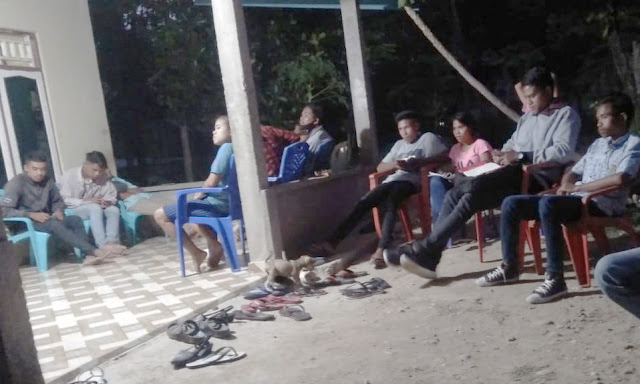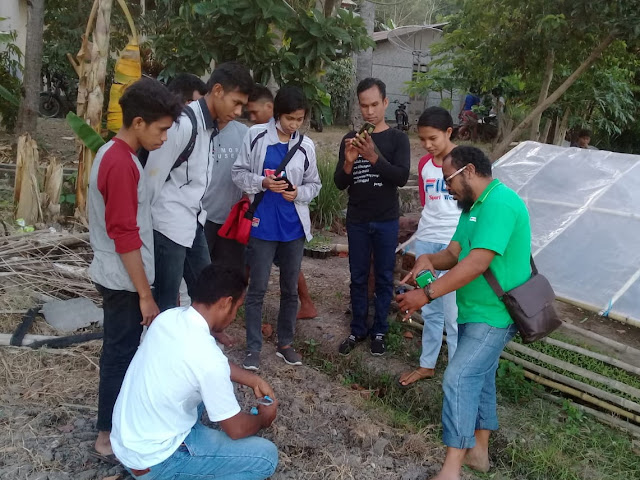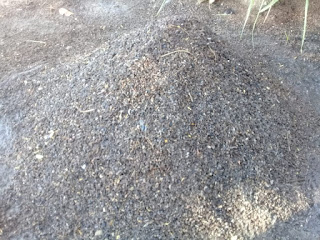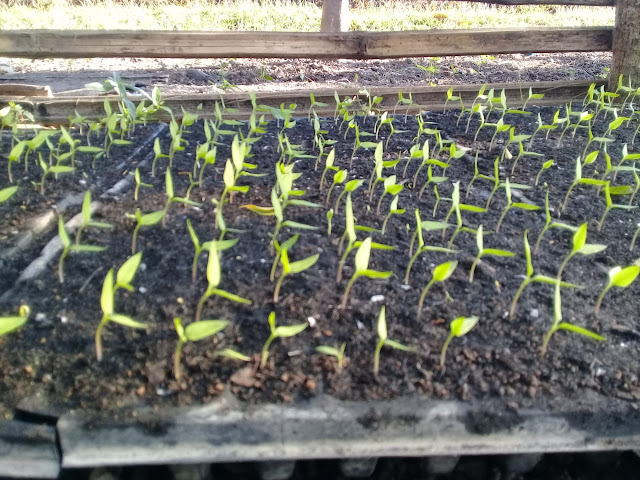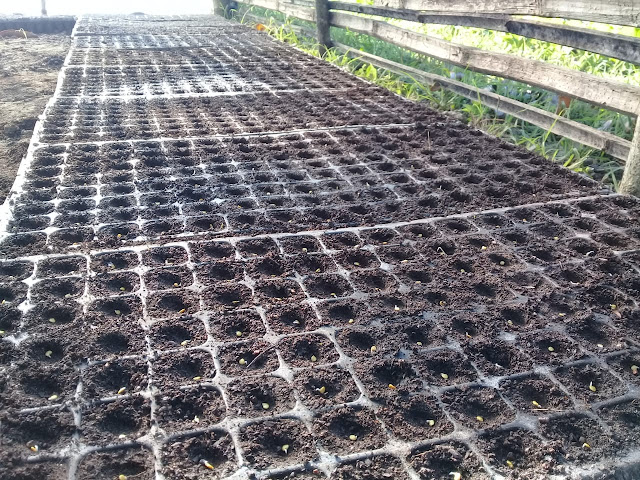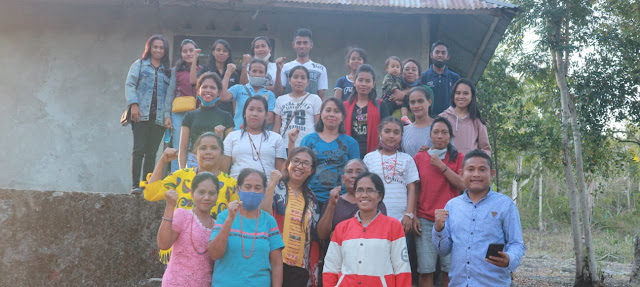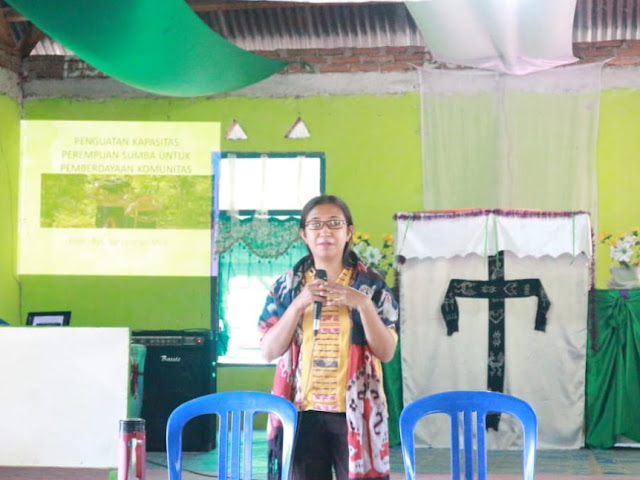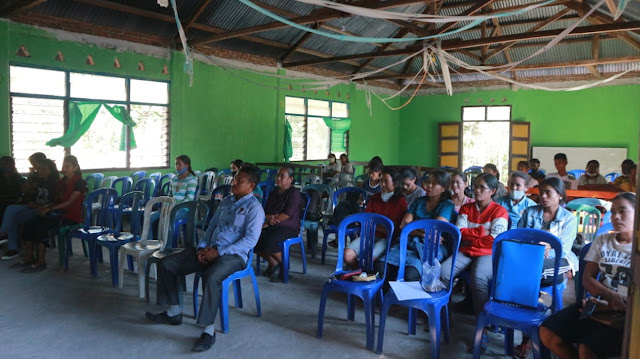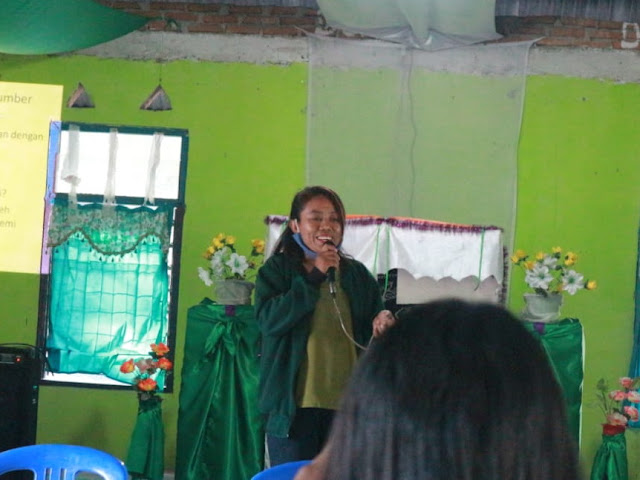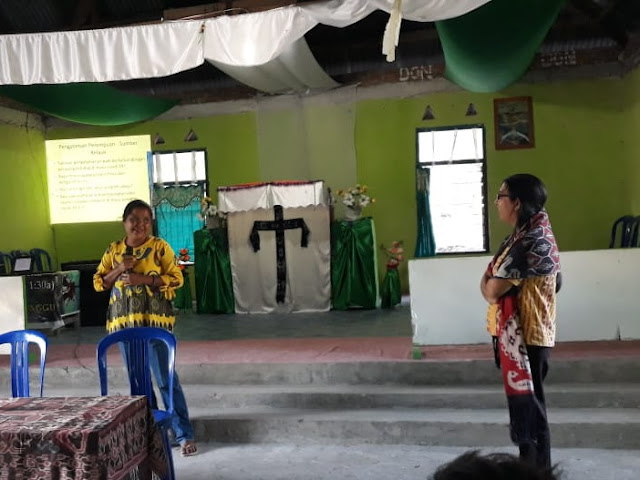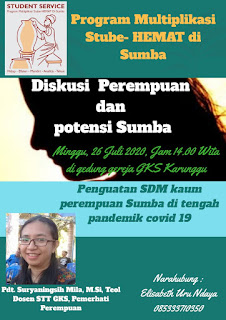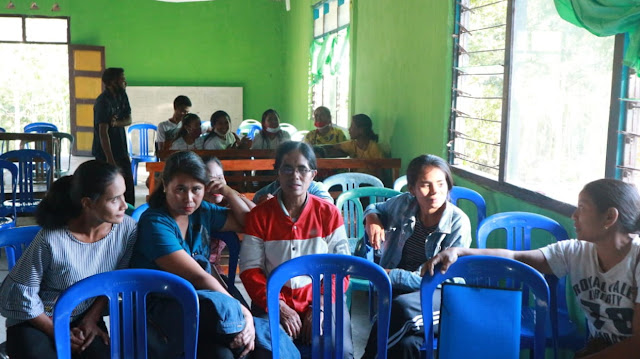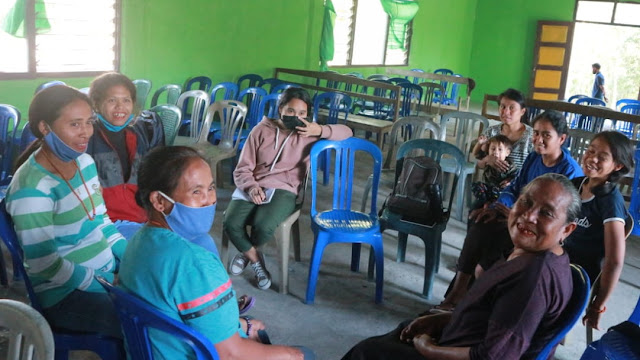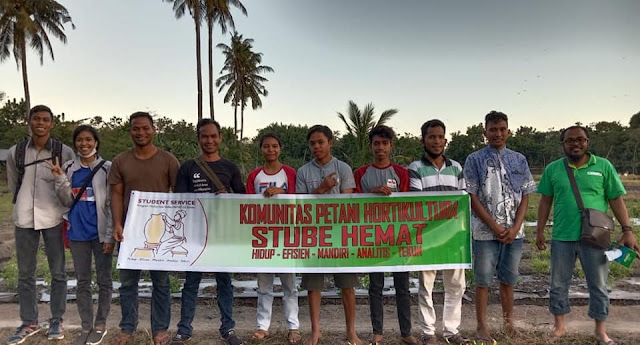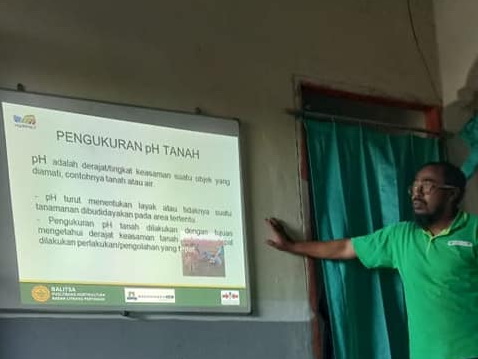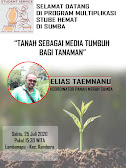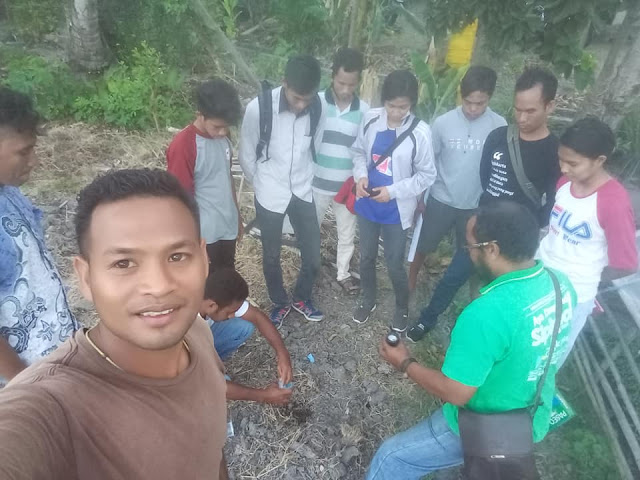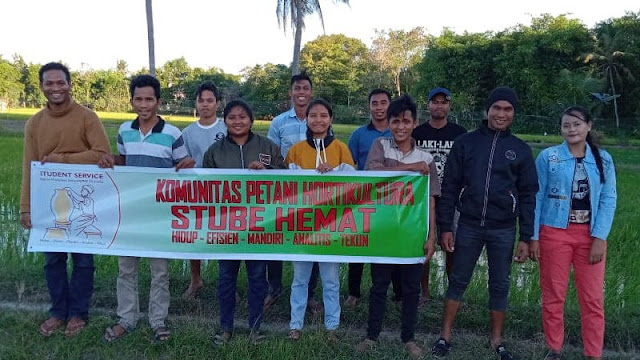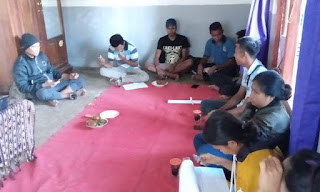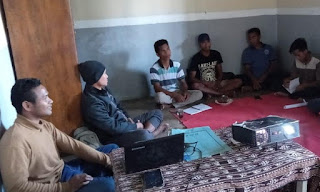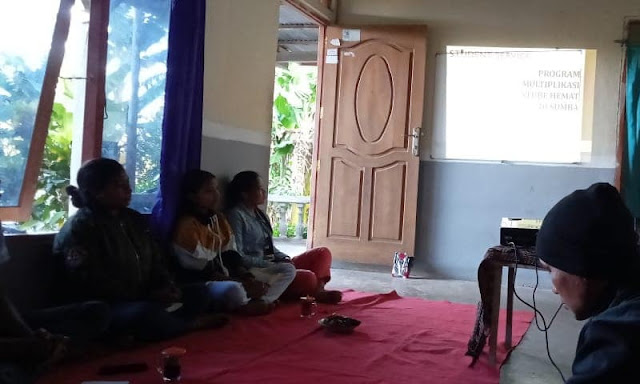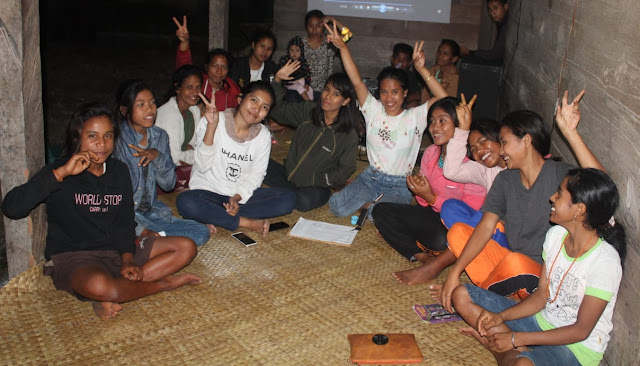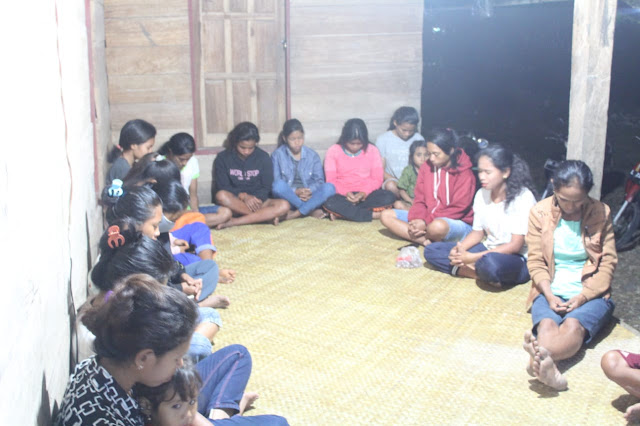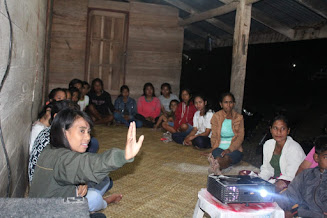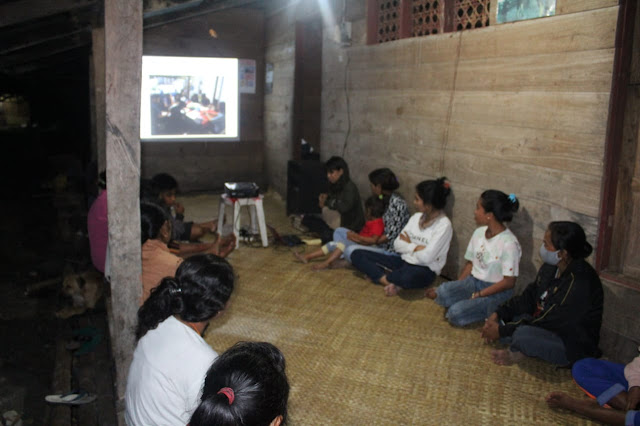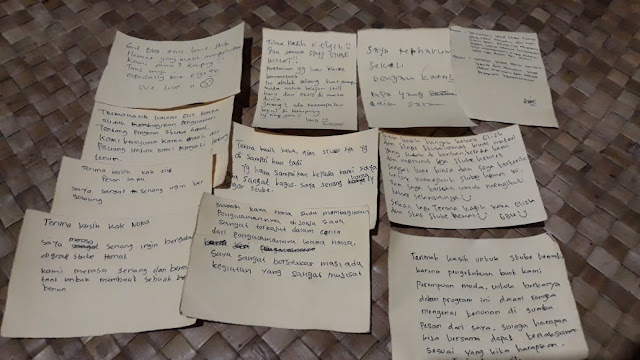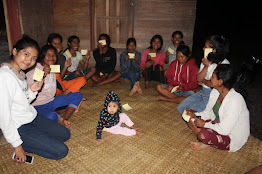Evaluation And Consolidation Of Weaving Groups
Monday, 14 December 2020by Elisabeth Uru Ndaya
By Elisabeth Uru Ndaya
Minister of Women Empowerment and Child Protection, Bintang Puspayoga revealed, based on national statistic data in 2019, 131 million populations almost half of Indonesia’s is women. This data illustrates that women are a contributor to half the strength of human resources in Indonesia. Currently, Indonesia faces various challenges to deal the covid 19 pandemic, both in terms of women's health and social-economic. In terms of the economy, many female workers are laid off from their jobs, and worse it will be more difficult for women who head families and lack-prosperous women to do businesses, due to the loss of distributors and markets.
The women empowerment program through the HEMAT Stube Multiplication in Sumba helped to answer the economic problems faced by most Sumba women today, especially in Tanatuku Village, Nggaha Ori Angu District. The strategic effort to answer the problem of the helplessness is to empower women through a weaving program that is currently being carried out.
Sunday, December 13, 2020, at 15.00 Sumba time, participants of the Stube HEMAT weaving group gathered to evaluate activities and consolidate the group that has been running for about 6 months. This activity was guided by May Nggiri, a representative of church council of Karunggu Sumba Christian Church (GKS) as well as participants of weaving groups. She is very grateful and grateful with the presence of the program from Stube HEMAT to make the young people and women in GKS Karunggu more productive. This program has helped the church with community empowerment.
Furthermore, Mama Yustina as a weaving coach evaluates the results of the group and provides motivation to the participants to keep passionate following the training, as well as revealing the group atmosphere, group compactness, work results and effectiveness of the group following each stage of weaving. She appreciated the spirit of group work in completing every stage. "I am very happy with the spirit of the participants learning to make woven cloth, although it is a little difficult and the participants often make mistakes but it does not make them stop learning. If you want to follow me to be a weaver, you have to keep up the spirit and follow every process that I teach so that you can master quickly," she said. Next, the participants were given the opportunity to share their experiences during the training. Mariance Danga (27 years old) said that it is the first time she knew and learned various stages in weaving.
After the evaluation and group consolidation, Mr. Nikodemus Makanggunggal, an assistant gospel teacher led the prayer together. This weaving group will continue to complete all stages, and now the group is preparing dyeing-yarn that has been tied to get coloring. Hopefully, the skills gained by the participants from this weaving group can help them to make production to improve the economy in the midst of pandemic situations. Let's fight the pandemic by being skilled and keep creative.***
Eco-friendly Using Natural Dyes
Saturday, 12 December 2020by adminstube
The beauty of Sumbanese woven cloth is so admirable, especially the natural colouring woven cloth. It looks elegant and unique. Each plant can be a source of natural dyes because of its natural pigments of its bark, stem, leaves, roots, and pulp. The potency of natural dyes is determined by the colour intensity produced and the color presented by the plant itself. Natural dyes have been recommended by many people as eco-friendly dyes either for the environment or human health because their natural components have a low pollution load and non-toxic.
One of the materials learned by the women weaving group of Tanatuku is the introduction of dyeing plants for weaving. The plants used as dyes can be found nearby their place, thus it saves costs. The advantages of natural dyes are the varied and unique colour, the color intensity nourish the eyes, and the antioxidants bring comfortable and safe to wear. The woven cloth of East Sumba generally uses dyes from the leaves of indigo (Indigofera) for the blue colour, the root of noni (Morinda citrifelia) for red colour, turmeric (Curcuma) produces yellow and candlenut.
On December 10-11, 2020, during the process of tying the yarns, the members of the weaving group explored the soaking stage of natural dyes. Mama Yustina, the weaving trainer, explained the use of Nila/Indigofera by using its leaves, stems, and roots. She invited them to pick up the Indigofera leaves in front of the house to practice from the soaking until getting the result. The natural dyes woven clothes have a high selling value or economic value because they have artistic value and distinctive colours so that they are ethnic and environmentally friendly. Each dyeing process takes almost a week because one cloth consists of three colours, so the complete colouring process can take one month. After all the colouring step is finished, the cloth must be soaked in candlenut oil, then dry it.
Currently, the stage of tying the yarns is complete, and it is waiting for the results of the dye mixture to soak it. The group members cannot wait to see their woven cloth is soaked in natural dyes, as a reference for proving the tying quality they made. After the colouring stage, they will enter the real process, the weaving process. It is the final process in the making of woven cloth manufacture which takes time, but the process may be completed on time because of their cooperative works.
The strong spirit of cooperativeness made the group active and alive. Currently, the weaving program is known by many people, not only in Tanatuku village but also the neighboring villages know the existence of the weaving group. Many of them have ordered scarves, sarongs, and clothes when the group supported by Stube HEMAT has produced their products. Keep up the spirit of the woman group.***
Finding Out the Natural Dyeing Plants
Monday, 7 December 2020by adminstube
By Elisabeth Uru Ndaya, S.Pd
On Saturday, December 4, 2020, the weaving group of Tanatuku continued the unfinished training on tying the motif. The activity was started at 13.00-17.00 WITA accompanied by Mama Yustina as the trainer. The progress of training through all the weaving stages was shown by the participants’ improvement, some are very good although there are still some mistakes, such as the knots that had to be opened and repeated because the ties were not tight enough. From this mistake, the trainer reminded that if the thread ties are not tight, the motif will not show the designed motif. The participants also realized that the quality of their weaving was determined by the persistence in practices. They were excited to fix it again. That is how the beginners have to go through a long process, from being unable to be able.
Besides the process of completing the yarns tying stage, the participants also prepare colouring materials for the 20 sarongs that are being worked on. If they want to use natural dyes, they have to think about how to get the materials, meanwhile, the natural colouring materials are not available nearby their place. The natural colouring plants are commonly found in the place where the weavers live. Luckily, Mama Yustina, the weaving trainer, comes from Lambanapu, a place of traditional weaving craftsmen and she has a garden for Indigofera plants.
On Sunday, December 6, 2020, after church service, the members of the weaving group accompanied by the trainer and several representatives from other weaving groups left for Lambanapu village, Kambera district to afford the natural dye. By using an open pick-up car, they spent about two hours for their journey. Although the group was wet because of the rain as it was the rainy season, it did not reduce the enthusiasm to get natural dyes. After arriving in the Indigofera garden, they were amazed by the vast Indigofera garden with its green and lush leaves. They immediately picked the leaves and put them in six big containers and returned to Tanatuku.
The Indigofera leaves are then cleaned and ready to soak in the provided container. The soaking process is carried out until they produce dregs and the soaking process is complete. Then the dregs of the Indigofera leaves are dried under the sun to dry. The last step is soaking the tied woven cloth into a container filled with water by mixing the dried Indigofera dregs. Let us continue the spirit of Tanatuku women, for the next stage.***
Practice Weaving While Gardening
Monday, 30 November 2020by Elisabeth Uru Ndaya, S.Pd.
Most of the inhabitants in Tanatuku village, Nggaha Ori Angu district are farmers. Cultivating fields is their daily life activity for years to produce foods, such as planting corn, rice, beans, sweet potatoes, and other crops. However, the effective time to cultivate the land is only during the rainy season, because the cultivation of the fields depends on the rainfall to irrigate their fields. Currently, the rainy season span from November to March. The stretch of hills and trees looks green and fresh again, the rice fields are filled with water again and stunningly green. Sumba is back with its new face.
The women weaving group in Tanatuku village felt the joy of the return to cultivate the fields and began to plant various kinds of crops. On Saturday, November 28, 2020, the group gathered again after gardening to evaluate the achievement of their weaving with Mama Yustina as the trainer. She said that the members had improved their skills in understanding each step. Once again, she emphasized the importance of being serious when tying the yarns in order to produce fine woven cloth motifs.
During the discussion, the women also talked about the preparation of the nursery fields for the colouring plants, meanwhile, the seeds are available and ready to be planted. The types of plants are Indigofera for blue colour and Noni (Kombu) which produces red. Generally, both are often planted by weavers, but other natural dyes can also be obtained by gathering them from the forest or buying them. The natural dyes can be got from various parts of plants, such as roots, wood, bark, leaves, fruit, seeds, and flowers.
After the drawn motif is tied, the next step is the colouring. The warp yarns (hemba) are dyed in natural dyes. Each dye is poured into a separate container, in past times, it used an earthen pot. The group members are so enthusiastic in colouring stage because they have never seen this. However, they will not enter this step if they have not completed the tying process. But their spirit of cooperativeness pushed their motivation to continue the process to complete the weaving step by step.
The presence of the Multiplication program of Stube HEMAT in Sumba provides a new atmosphere and hope for the residents of Tanatuku village, especially the weaving group members who are in the process of weaving. Formerly they were only busy on gardening, now they have an alternative on weaving. The program is expected to raise their economy when their products are marketed and sold. ***
Learning Nutrition for Horticultural Plant
Sunday, 29 November 2020by Frans Fredy Kalikit Bara
Plants and humans are the living beings. Humans need four perfect five healthy foods, and so plants need nutrients for maximum growth. The process of providing horticultural plant nutrition is divided into two phases, namely vegetative phase and generative phase.
Simple definition of nutrients is foods, vitamins needed by living beings. There are several characteristics that are seen when horticultural crops are malnourished, namely stunted growth, plants will be easily affected by diseases leading to crop failure, the appearance of curly leaves and yellow color.
The discussion (11/28/2020) with this material was attended by eleven students. The atmosphere of this discussion is quite interesting because there is very active communication between presenters and participants. Participants asked many questions because this material is a basic science used to answer agricultural problems related to nutrition. The participants had different educational backgrounds so this material was new and useful. Although the educational background is different, they have a farmer's family background, therefore the explanation presented is considered important. Another interesting activity is visiting the horticultural farmland in the area near Laipori beach facilitated by professional farmers named Welem.
Horticultural plants need macro and micronutrients. Macronutrients include; 1) Nitrogen, for the growth of leaves, roots and stems, part of green leaves for photosynthesis. The old leaves of Nitrogen-deficient plants will look completely yellow; 2) Phosphorus, useful to spur root growth, sprouts, flowers and fruits. Horticultural plants that lack phosphorus will dwarf, short stem segments, black tips and edges of leaves, and the edges of the leaves are curved down starting from old leaves; 3) Potassium, strengthening the cell wall to survive form disease attack. Plants with less potassium will have inhibited growth, small leaves size with dark greenish, the edges leaves are brown and falling leaves. 4) Calcium, serves to spur the growth of plant root tips and to strengthen cell walls. Plants that lack calcium will have no roots growth, root tips are weak, the shape of the leaves are changing.
The secondary nutrients that plants need are: 1) Magnesium, as the main ingredient of chlorophyll formation. Plants that lack magnesium will have yellow leaves starting from the old leaves though the bones of the leaves remain green. 2) Sulfur is part of proteins, cell-forming materials, organs and plant tissues. There are several types of micronutrients, namely iron (Fe), manganese (Mn), zinc (Zn), copper (Cu), boron (B), Molybdenum (Mo), and Chlor (Cl).
The availability of nutrients in the soil needs to be considered important by farmers. Planting patterns focused on one plant tend to reduce the amount of nutrients in the soil, so crop rotation needs to be done to maintain the availability of these nutrients. Examples of crop rotation that can be done are first, from rice fields to horticultural crops type of beans or second, from tomatoes to legumes. In addition, farmers need to sow manure on land before planting. Have a good practice.***
Recognizing the characteristics of horticultural farmers at Laipori coastline
Sunday, 29 November 2020by Frans Fredi Kalikit Bara
The air temperature at the seashore is hotter and drier than in the middle and highlands. Most farmers do not do farming activities in high and hot temperatures, but what Welem did is the contrary. Currently, Welem (37) decided to start an agricultural business in 2012. His former job was an employee at PT. Kapas and worked at PT. Gold Wangga Meti. These two corporate companies suffered from a setback and finally stopped the production activities. In this condition, Welem and his co-workers lost their job and their income was cut off. Finally, he decided to work on horticultural farming. The beginning of this business left stories of failures, but for Welem the failures were valuable experiences for learning, self-evaluation, and a stepping stone to bounce back.
There were several obstacles that Welem faced when starting a business, such as a lack of knowledge of seeds, pest and disease control, plant nutrition (lack of understanding of horticultural cultivation techniques). There were several important points conveyed by Welem in this discussion, namely: 1) Being a farmer must be based on innovation so that we can achieve the maximum production rate, 2) Never be ashamed of this work. Currently, many young people are ashamed to work as farmers, therefore they avoid this job, 3) Doing brainstorm to lift the degree of farmers as motivation for themselves to engage in agricultural business, because the income is not much different from those who work in institutions, 4) Do not be afraid of market demand, farmers should have a market calendar and planting calendar to reach the volume of production and the market demands, 5) Farmers always have time both for business and development, and for their families. Therefore happy farmers are shown by physical characteristics of the chubby figure and bright face.
The discussion held on the Laipori fields (28/11/2020) was attended by ten enthusiastic participants, because besides listening to the interesting explanations from the presenters they could also see the surrounding fields filled with fruit plants, also enjoy the fresh watermelons that were served. Besides students, there were teachers, farmers, and members of the church council. From these different professional backgrounds, they have one goal to learn how to be independent for the food supply in Sumba.
One of the elders in the discussion, Bora Ghunu (65) gave his advice, "If you want to live, don't be lazy, having graduated from schools, you must return to agriculture work". He intended to motivate the young participants who attended this training. Agricultural business is a lively business, considering the current condition that most of the young people are not working as farmers so that many potencies in real sectors are left unmanaged. Get the spirit on farming, young people! ***
Swine Breeder Group & Animal Husbandry Department of East Sumba Regency
Saturday, 14 November 2020by adminstube
One interesting thing in the midst of the ASF (African Swine Fever) virus attack on pigs in East Sumba is that the breeders continue to consolidate in groups and continue to look for answers how to deal it. Motivated by the multiplicator of Stube HEMAT in Sumba, Apriyanto Hangga invited breeders and resource persons from the Animal Husbandry Department of East Sumba regency to meet and interact about pigs in a one-day training in his residence (13/11/2020).
This activity is one of Animal Husbandry Training Program series that have been implemented before. Due to good cooperation, the Animal Husbandry Department sent 3 veterinarians to interact with the community. The major topics discussed at the meeting were the Recent Development of Swine Farming in East Sumba, both in terms of population-disease eradication, and fulfillment of livestock needs. Many things were discussed on this occasion because people who were competent in the field of pig livestock were present so that the atmosphere was very fluid and the community could tell the problems they face related to their livestock. Umbu Ridwan Premajangga, a veterinarian spoke specifically on "Pig population and development, and disease eradication", while Hendrina Meha (a veterinarian) spoke specifically on “Animal Nutrition” and Rambu Mersy (a veterinarian) presented “Livestock breeding and infectious diseases in livestock and prevention”.
The Animal Husbandry Department has vaccinated 70.000 pigs, but the real number of pigs goes beyond that number because many pigs are not vaccinated for various reasons. Since February 2020, many pigs in East Sumba have been infected by the ASF Virus, and the estimated death toll reached more than 5.000. It was alleged that the cases were ignited by inter-island deliveries of pigs and the sale of pork-based foods from infected areas, such as the delivery of ‘pork se'i’ and pork bread from Kupang and nearby, so that the pigs in East Sumba infected by this deadly virus that has no cure yet.
The needs of pork temporarily are supplied by meat from large livestock such as beef or poultry such as chicken because people are prohibited to bring in livestock or food containing pork from anywhere until now.
Some points that can be concluded are as follows:
1. A breeder group has been formed with 20 breeders as members.
2. The cage must be clean and must be sterilized.
3. Never give livestock leftovers, especially leftovers contain pork.
4. Never eat suspicious porks.
5. Pigs must be routinely given the vaccine every 6 months.
6. If a pig dies, it must be buried or burned.
7. Livestocks should be provided with clean and nutritious food.
8. Do not bring in livestock or food containing pork from outside.
9. If there are symptoms of illness in the livestock, never give the injection by yourself but report it to the agent or the Animal Husbandry Department.
10. Do not be afraid to raise pigs as long as the cage is proper, clean, and has good control.
Keep your spirit the pig breeders in East Sumba to bring progress. ***
Hondung, Thread Binding (Women's Group of Tanatuku Learns to Weave)
Thursday, 5 November 2020by Elisabeth Uru Ndaya, S.Pd
Weaving art is closely related to the systems of knowledge, culture, belief, environment and social organizational systems of the society. The quality of weaving is usually seen from the quality of the materials, the beauty of the color, motifs, patterns and variety of decorations. To produce quality work, it is necessary to work hard in learning and following every weaving process, such as in the process of binding the thread on the lungsin (hemba). The columns that have been drawn or designed, are tightly tied so that the thread does not shift while or after the motif is drawn or when it is tied. This stage should be thorough (drawing and binding) because the tightly tied warp thread sheet consists of 4 to 10 liran/layer (hanai). In 1 liran, there are about 2.520 strands of yarn, and to produce 1 sheet of cloth it takes at least 2 liran so that there are about 5.040 strands of yarn in one sheet of woven cloth. Further, one time drawing or tying motifs will produce multiple cloth with the same motif.
On Wednesday, November 4, 2020, the weaving group in Tanatuku continue to practise the process of drawing and tying motifs, guided by weaving coach Mama Yustina. The purpose of binding a thread (hondung) is the originally white thread if it is tied, and the motif that is covered by plastic rope will not be exposed to dye. Similarly, when the motif will be colored red and other colors, so that later when it is dyed blue, the tied part will not be exposed to blue dye. Mama Yustina insists that the important thing to note when drawing and tying motifs is to distinguish the knots of the ties, so that after coloring process, there is no mistake in the order of opening the ties.
Sherli Konda Ngguna, a weaving group participant asked in the local language, "Nggiki hama ka nyuma yia ba ndapa pingu a pa image, ma nggambar la karata a ma njala manu, rihi ka la luakamba?" (what about us who are not good at drawing, it is hard drawing just on paper what about motif on a thread?). Mama Yustina explained, "Indeed, drawing directly on the thread is done by the expert because when it is wrong it will be difficult to remove the scars of the image because later the thread strands will be thinning, but it does not harm if you want to train yourself, because next you will draw yourself, then have to be more enterprising in learning to design motifs", she explained. Tying the thread or hondung is usually done very tightly so that the bound part is not affected by the color. Well, it is not as easy as it seems, raffia straps should be treated with caution, too forced will break it up, otherwise, the toned dyes can filtrate and damage the results of weaving cloth.
There are currently 5 lungsin (hemba) presented in a device called kapala that is in the process of bonding. And each kapala has 8 layers or liran. From these 8 liran will later produce 20 sheets of woven cloth. Therefore, the participants of the tie weaving group are very enthusiastic to do the process of tying. The passion to be able to produce homemade cloth makes them impatient to come to the next stage. There is a sense of pride to master the weaving crafts. May their togetherness keep them synergizing for their welfare. ***
Morning Greetings 2: Young Activists in Sumba Island
Tuesday, 20 October 2020by adminstube
The trip to visit multiplicators on two islands, Alor and Sumba, gave impression to the board members who had the opportunity to meet them. The followings are notes and impressions from Pdt. (Emeritus) Bambang Sumbodo, S.Th., M.Min after observing the local area and meeting personally.
Elisabeth Uru Ndaya, has graduated from English Education in Yogyakarta. His father is a gospel teacher (pastor assistant) in GKS (Sumbanese Christian Church), a small church in Tanatuku, Makamenggit, about 50 kms from Waingapu. After finishing her study in Yogya, she returned to her hometown to gather Sumbanese women to make Sumbanese weaving crafts. Her efforts to gather and empower women there were not easy, because of many obstacles and challenges, such as a husband forbade his wife to participate the training. Elis did extraordinary approach towards the husband who forbade his wife, she involved the church and the pastor for advice. Finally, everyone allowed their wives to join women activities of Stube HEMAT in their village.
Now they have learned to make Sumbanese tied weaving as well as coloring from plants and established training center for weaving. There is a mother who already have a gallery and earned money to support the domestic needs. When they practiced weaving their children also came along and sometimes they made a hassle, but on the other side they introduced their children about weaving, especially girls to love Sumbanese tied weaving which is starting to fade.
Elis is also an English teacher, so she was motivated to set up an English learning group for children, and she did all with wholehearted. The training on Sumbanese tied weaving was attended by 20 women. May God bless them to strengthen their families as well as the church, because they are actually the preacher of the good news. Keep fighting to face the challenge, Elis, Immanuel.
Yulius Rihi Anawaru, a forestry-graduated from a campus in Yogyakarta. We discussed a lot about Sumba and its young people. Yulius has done reforestation by planting thousand trees in his village. Then he received God's blessing, by working together to buy a boat to cultivate seaweed at Warabadi beach, East Sumba. Yulius involves Andreas to supervise and maintain the boat and take care the seaweed, and from the seaweed Andreas sent his children to college. Praise God, the harvests are so satisfying. The children and teenagers were invited to go boating around the sea and to learn about sea and seaweed cultivation.
Apriyanto Hangga, studied Governance at Village Community Development Academy in Yogyakarta. He has been a student activist since he was in Yogyakarta and now he mobilizes the community in Mbinudita, about 120 kms away from Waingapu, East Sumba to rebuild Parallel Elementary School which collapsed in 2019 because of hurricane. Through social media Yanto managed to raise sponsors to build elementary school building and mobilized the community to work together. The workers of the construction are from Nganjuk, East Java. The location of the building is on the top of a hill and surrounded by villages. This Parallel School brings school which are about 4 to 6 kms away closer to children on foot. After the establishment of the school, the children walked just 2-3 kms. This school is designed to be finished at the end of this year, and it is expected to be used when the pandemic ends. Currently, teachers visit students one by one from one house to another. Apriyanto also raises pigs, however virus has attacked pigs in Sumba and led thousands of pigs in Sumba died, including Apriyanto’s and his group's livestock. Together with Stube HEMAT, Apriyanto and several students discussed and learned how to overcome this virus.
Frans Fredi Kalikit Bara. Previously Frans was a candidate for Catholic priest, but he resigned because his parents asked him to continue the lineage of family. Now he is writing his thesis at Wirawacana Christian University, in Waingapu, East Sumba. Frans has ever invited to Yogyakarta to take part in Stube HEMAT Yogyakarta training, such as training on creative products, journalism, organic farming, and farming on dry land. It has been almost 5 years since then, now he is cultivating chilli, tomato, watermelon, mustard greens, cabbage, with very good results. Until now, the needs of agricultural products in Sumba are still supplied from outside of Sumba island, so he formed a group of young farmers to develop organic farming. They are assets of the nation in food fields, rice barns and other agricultural products.
Local Potential to Overcome Pig Virus
Monday, 19 October 2020by Apriyanto Hangga
Saturday (10/17/2020) at Wai-Wai, Lewa, Pameti Karata, 25 students, youth and farmers gathered for one day training with Multiplicator of Stube HEMAT in Sumba focusing on livestock, accompanied by Yahya Rohi Aba, S.Pd, as a facilitator talking about animal husbandry as a continuation of the Livestock Training phase 1, II, III and currently it was the fourth activity. There were 2 agendas carried out covering: (1) visiting and seeing the breeding process of sows, and (2) concocting pig food using local ingredients that is cheap, nutritious and healthy for the livestock.
Yahya Rohi Aba S,Pd., has a pig farm with 15 sows, 3 males and 50 piglets that are ready to be marketed because they are 1-2 months old, with the lowest price range of Rp 1,500,000 for 1 month and 2 weeks piglet. This farm is one example of a healthy farm in the midst of the pig virus outbreak that attacked Sumba. With the collaboration of 30% students and 70% pig breeders, participants learned many things: (a) learning how to maintain and care pigs, (b) learning how to choose superior seedlings both females and males, (c) how to mate and to care the post mating pigs, (d) how to care lambing pigs and special strategies to care for and keep piglets to be healthy and thrive.
Learning directly in the stables becomes one interesting thing after the introductory session and question and aswer. Yahya explained several important things such as the selection of superior breeds of seedlings both females and males, because to get a good brood, we must choose good and superior varieties/genes, such as durog, leandris, broiler or crossbreed varieties. Super males are an important factor because although the sow is not a super variety but the male is super, then all the piglets will be super. Many things are important lessons for the participants such as the process of mating pigs, understanding the period of pigs bring forth, and the care of nursing sows and piglets.
The last part is to concoct animal feed using local material. Animal feed is one of the main factors in the modern pig maintenance process in Sumba because most of the animal feed is imported from Java island so that it makes the price expensive. That’s why farmers must be able to use local materials to reduce the cost of feed that is around 65% of the price of the livestock. Animal feed materials are available enough in Sumba but because people think that the best and nutritious feed are sold, they bought at stores with very expensive price. Actually the local materials are available and ready to mix including corn, cassava, rice pulp, other tubers and tofu pulp.
Finally, it is expected that this activity opens new thoughts and new ways to raise pigs in Sumba.***
Exploring the Motif Design of Sumbanese Tied Weaving
Monday, 19 October 2020by Elisabeth Uru Ndaya, S.Pd
It is important to maintain the values and tradition of the ancestors so the existing cultures and diversity are not eroded by time. As a beginner, the Tanatuku weaving group continues to be enthusiastic in practicing weaving step by step. This time, they explore the motif design of Sumbanese tied weaving.
The training on October 7 and 17, 2020 invited and directed the participants to design woven motifs on sheet of paper with various motifs, such as horse, rooster, mamuli, human, flower, dragon, and house. The process is felt hard because those who invited to draw were no longer pupils or kindergarten children, but students, youths and mothers. Some of them admitted that they never drew anything since they were young, so when they were given a sheet of paper and stationeries, they looked confused and afraid to start. Some others tried to draw a horse motif but the drawing did not look like a horse. However, the available printed sample motifs made them easier to practice drawing motifs.
There are many levels of difficulty they face during working the weaving, but it does not dampen their enthusiasm to keep practicing. A professional weaver is required to have creative ideas to design motifs, in addition to produce the uniqueness of the group's design motifs. There are three parts of woven patterns or motifs that are known in East Sumba, such as the figurative part, which is representation of human and animal patterns, the schematic part, which resembles a series of charts, geometric shapes, and forms of foreign influence, namely the cross, lion, crown, petola pattern (Indian cloth) or dragon (Chinese cloth).
The uniqueness of the design created is a work that reflects elements closely related to the culture of the region itself. The following are examples of motif variations based on production areas in East Sumba.
(1) Kambera district has 18 motifs, such as patuala ratu (Patola cloth), Habaku (Flying lizard), Karihu (Butterfly), andung (skull monument), mahang (lion), kurang (shrimp), manu (rooster), wuya (crocodile), karawulang (tortoise), lodu (sun), wulang (moon). (2) Kanatang district has three motifs, namely ruha (deer), mahang (lion), kaka (parrot). (3) Pahunga Lodu district has 11 motifs, namely Andung (skull monument), mahang (lion), kurang (shrimp), habaku (flying lizard), wuya (crocodile), karawulang (tortoise), karihu (butterfly), mandu (snake), kaka (parrot), ngganda (a type of flower), tanga wahil (betel container), and (4) Kaliuda has 3 motifs, namely horse, rooster and coastal bird.
The motifs above are the works of 3 out of 22 districts in East Sumba. Thus, it can be concluded that only three districts have been working on tied weaving. Therefore, the existence of Tanatuku weaving group is expected to represent the district of Nggaha Ori Angu for tied weaving in East Sumba with their own patterns or motifs. Hopefully the learning spirit of the weaving group will last and finally will bring out skillful weavers to produce woven cloth of East Sumba.
Recognizing the Motif Design of Sumbanese Tied Weaving
Saturday, 19 September 2020by Elisabeth Uru Ndaya, S.Pd
An established forum or community is certainly passed through long process and dynamics. The commitment to be part of it became the new spirit and principle performed by women in Tanatuku village. Formerly, the weaving that was strange to their ears now has become part of their activities and life stories. Their great curiosity and the longing to be part of the tied weaving culture of East Sumba made the women of Stube HEMAT so enthusiastic in practicing tied weaving. The solidarity among them became the main asset they have created continuously to carry out a sustainable activity.
Since September 16, 2020, every Wednesday and Friday are their agenda for training. They learn the process of weaving step by step, from spinning the yarns, yarns bundling, and currently designing motifs and tying the yarns. Before tying the yarns, the bundled yarns are tightened and fitted in a tool, called 'kapala' for a week, to make them easier to tie. During the yarns bundling process, the participants are invited to think about the various kinds of woven motifs in East Sumba and the meaning of each motif. Even though they know about woven cloth motifs, only few of them understand the meaning and symbol of each motif.
Therefore, during the session Mama Yustina, as the trainer, explained the meaning of several motifs they often used. The horse motif determines the social status of Sumbanese people. It symbolizes masculinity, courage, agility and heroism. The rooster motif shows the main work of the Sumbanese as breeders. It symbolizes consciousness, masculinity, a sign of life and a leader who is ready to protect. The parrot motif symbolizes unity and integrity, reflecting the spirit of the Sumbanese people to make decisions of affairs through deliberation or consensus. The human motif symbolizes the repulsion of evil, and contains supernatural powers and every human being needs recognition, attention, appreciation and love from others. The naked human motif symbolizes innocence, solitude, fear and poverty. The snake motif symbolizes arrogance, vanity, human side that is full of anger, vengeance and looking for chance to defeat the opponent. The deer motif with the splendor of its horns symbolizes the courage, majesty and wisdom of a leader in society. The shrimp motif symbolizes brotherhood, unity and oneness. The crocodile and tortoise motifs symbolize greatness, supernatural powers and have great influence.
Currently, women community of Stube HEMAT is designing horse motifs. While completing the bundled yarns they begin to imagine how to design and draw horse motif on the yarns. The motifs are decorated on yarns that have been bundled and tied based on the existing design. In the next meeting they will learn the process to design and to tie the yarns. This process requires high concentration because they have to think about the design of the motif, how to design and to tie the yarns. Let us keep up the spirit of the women community to master their own culture.***
All about Tied Weaving of Sumba
Monday, 10 August 2020by Elisabeth Uru Ndaya, S.Pd
Humans, both individual and group, cannot be separated from their identities as cultural beings. The culture itself consist of a set of attitudes, beliefs and behaviors communicated from generation to generation as means adopted by each society. The art of weaving is an old culture that humans are engaged in to produce clothing and heritage of civilization that almost be found all around the world. From the various woven fabrics of East Indonesia, in East Nusa Tenggara, Sumba is one of the islands producing woven fabrics which is very famous for its beauty and various motifs. Therefore, it is important to have inheritance and regeneration to young people as the next generation in order to maintain the cultural preservation.
On Sunday, August 9, 2020, Stube-HEMAT Multiplication Program in Sumba held a discussion at GKS Karunggu with a theme ‘Revealing the History about Tied Weaving of Sumba’, attended by dozens of women who have longing in weaving with Marta Harakay, a weaving craftswoman from Kalu, Kambera district, Waingapu. She said that people began to work on weaving since the 4th century to produce cloths. At that time the woven fabric was not made of yarn but spunned directly from cotton to make a piece of woven cloth. Each step, from tying the yarns, dyeing it until to the weaving process should be done carefully even sometimes it takes 6 months to 3 years because in addition to weaving and making motifs, the cloth should be aerated for a month before being dipped in candlenut oil. Another stage in making Sumba cloths also tests patience, such as storing them in a closed basket to ripen the color and the nature will involve in the process so that the cloth becomes more unique. Marts also explained the meaning of the motifs on the woven fabric.
The participants seemed so enthusiastic when listening the speakers’ explanations. Among them, there were 3 women who engaged in weaving but not all of them knew all process. They knew only the partly process, such as some others knew only about the yarns, coloring, or weaving, but no one knows each step, even the others did not understand at all. Astry Banju shared her story, she was known as a weaving craftswoman but actually she could not weave, only in dyeing and yarn-grouping, then her mother-in-law did the weaving, because when she tried to weave, the results were not good.
The different story from Mama Ferdi, she could do steps to weave, but she lacked experience in coloring, and the products were not good in colour, while Adriana Tanggu Hana wanted to weave but no one trained her, finally she did not do anything. She hoped this program gave her chance to learn weaving. The participants’ experiences above discovered new understanding that weaving need a long and persistent process. This discussion opened opportunity for them to collaborate each other, to learn from one to another and to share experiences.
Marta Harakay, the expert in weaving, reminded the participants that learning to weave is uneasy, but it needs strong commitment dan motivation to make it. She also gave some tips how to weave well to produce good stuffs, covering the sitting position, proper posture, tight back ties, plus the leg kicking to the loom must be strong enough. Likewise with the coloring, it is important to pay attention to the mixed ingredients and the color combination in order to get beautiful colors.
At the end of the discussion, they formed a weaving group called ‘Kawara Panamung’ with meaning of ‘embracing each other’. After that, they wrote on some pieces of paper their messages and hopes for the community they had formed. Hopefully, the group will help women to be creative and to produce good woven fabrics with Makamenggit's weaving typical, supporting the economic of women here. Next, the group will visit a weaving village to observe and to learn new things about weaving. ***
Women and The House Yards: Food Solution during Pandemic
Tuesday, 4 August 2020by Elisabeth Uru Ndaya, S.Pd
The dry season is the season when farmers in the southern part of East Sumba generally take rest, they do not farm or cultivate the land because the soil is dry, so it is difficult to grow any plants there. This condition is faced by farmers every year, especially in Lewa, Makamenggit area. Only during the rainy season they cultivate the land. The time span of the dry season is from May to November (8 months), and during that season most farmers, especially women, stay at home and rarely do other activities. Moreover, the pandemic force everyone to stay at home and make women unproductive.
This condition is not supposed to make people unproductive, instead various activities can be carried out, especially activities that can supply household food needs. One option that can be done is vegetable gardening in the house yards. This is what the women's community of Stube HEMAT is doing here. Started from an understanding how to take advantage of the existing potency as the facilitator of the discussion, Pdt. Suryaningsih Mila, M.Si. Teol, shared to the participants, it became a new enthusiasm to optimize the house yards by making vegetable beds.
On August 3, 2020, the women in this village started to set fence around the vegetable beds. There are two locations used, at the church yard for vegetables and at the yard of Iche Hana's house for the nursery of natural colouring plants for their traditional weaving. Iche Hana, a weaver and young activist, admitted that she was very happy with the enthusiasm of the women here to optimize their house yards, even dry, did not dampen their enthusiasm to synergize.
Kalita Mboru, a woman activist, the head of PAUD (pre-school) Bina Kasih, and also the head of Tanatuku village health team, commented about the establisment of women's community in this village. "I am happy for the Stube HEMAT program here, so the women here do not just prepare the food and stay at home, but we can support the economic condition of our family by planting vegetables and learning traditional weaving", she said. She thanked to Stube HEMAT for being ready to support the activity and there will be good cooperation.
The two vegetable beds that have been made require sufficient water during the dry season, however it did not reduce the motivation of the community to take advantage of the existing potency and help their families daily needs. They applied a method to pay monthly fee of Rp 5.000 per participant. From 20 members they bought a tank of water for Rp 100.000 per month to supply water needs for the vegetable beds and the nursery. Meanwhile, the community distribute schedule to take care the plantantion, such as watering and caring for the plants. Keep moving women to ignite enthusiasm and cooperation. ***
Finding Out Solutions for Pigs Massive Death
Thursday, 30 July 2020by Apriyanto Hangga, A.Md
Pig farming is a primary activity done by people in Sumba based on their traditional life. Raising pigs is not their main work but a complementary because pigs are needed for the people of Sumba related to customs, burial, marriage or any other occasions.
Currently, the people of Sumba are devastated by disease that attacks pigs, namely Hog Cholera and the ASF virus. Thousand of pigs in Sumba suddenly diedy and cannot be overcome until now. The people seemed to give up with the condition and did not know what to do to overcome it.
For this reason, the Multiplication of Stube HEMAT in Sumba especially the Livestock Program provided assistance and training for students, church youth and farming communities who suffered from the impacts of this disaster. The discussion was so interesting because it fitted with the context of reality in the society. The participants of the discussion on Pig Farming (29/07/2020) exceeded the target from 25 to 43 participants, and the estimated time was 3 hours expanded to 5 hours due to their high enthusiasm. Moreover, the resource persons, Yessy Tamu Ina, S.Pt, M.Si, a lecturer at Faculty of Animal Husbandry of Unkriswina Sumba and field assistants team for small farmer community, answered all participants’ questions and curiosity.
The material presented by the source persons discovered many types of diseases that often attack pigs and it needed to be known by the breeders, such as: Vitamin A deficiency, Anemia, White Diarrhea, Hog Cholera, Agalactia, Smallpox, Rounded worm, Pneumonia and African swine fever (ASF) virus. Hog Cholera is a disease that often attacks pigs but this disease can be overcome by vaccine, so it is not too frightening for the farmer. If the livestock is routinely vaccinated, the livestock is guaranteed safe. However, the most dangerous is the African Swine Fever (ASF) virus. This virus is very dangerous because of its fatality and possibly kill all pigs around the affected area. It is possible this type of virus caused thousands and even tens of thousands of pigs throughout Sumba died. The worst news is the vaccine has not been invented yet.
The discussion led to several conclusions: Every breeder must keep the cage clean, Maintain the nutrition balance for the livestock, Having routine vaccination per 6 months (1 syringe per pig), If pigs are found sick or died, report to the agency immediately, If pigs are found sick, they should be separated from others. If you consume pork, only the leftovers with contain pork can be given to pigs.
During the discussion, the participants were actively involved by asking questions and conveying their experiences because the topic talked about the actual problem in Sumba and closely related to their daily activities. ***
Soil, Media for Growing Crops
Monday, 27 July 2020by Frans Fredi Kalikit Bara
Soil is a natural media needed by farmers to grow crops. The first step that must be done by farmers before carrying out the planting process is preparation of the planting fields. In this process, the degree of soil acidity must be measured to ensure the level of soil fertility at certain fields. The good soil pH ranges from 6,5 to 7,5. Meanwhile, the soil at level six is not good media for growing plants. Soil as a growing media like a bed for plants to provide comfort, if the bed is uncomfortable then the plants will not grow well.
There are several characteristics that will be shown by plants if the soil is acidic or neutral pH. The characteristics of plants that grow on acidic soil are: (1) the plant will be stunted because the root growth is stunted, so unable to absorb nutrients optimally; (2) the leaves’ surface will looked pale yellow because the nitrogen element in the soil cannot be absorbed, (3) the level of immunity to pests and diseases will weaken so that the plant is vulnerable to disease. (4) production yields will decrease and even crop failure.
Whereas the characteristics of plants that are in neutral soil are: (1) The condition of the plant looked greenish because of the optimal absorption of nutrients, (2) the condition of roots and stems looked solid, the leaves are wide, thick and dark green, (3) have maximum production level, and (4) have a high level of immunity against pests and diseases.
Several strategies that can be carried out by farmers if the soil acidity is below six are as follows (1) Do crop rotation with different types of plants or families, in order to neutralize the soil pH condition, or in other words, restore the macro and micronutrients of the soil that have been absorbed. An example of crop rotation with different families is the first phase of the fields is chilies, then in the following phase is legume crops; (2) Have agricultural lime or dolomite. The sown of dolomite on acidic soil will restore the soil into neutral condition; (3) Add the acidic soil with macronutrients, such as phosphate. It enables plants to grow in abnormal soil pH condition by stimulating the growth of new roots and maximize the stem growth, so that the crops are able to absorb nutrients for their growth and to produce optimally. ***
Women and Potency of Sumba
Monday, 27 July 2020by Elisabeth Uru Ndaya, S.Pd
Women are the pioneers of change, and this can start from family to community. They have extra inner power to survive in crises including the pandemic of Covid-19. Evidently many women are looking for alternative business during the pandemic for their families to survive.
On Sunday, July 26, 2020 in one discussion held by Multiplication of Stube HEMAT in Sumba, Rev. Suryaningsih Mila, M.Si.Teol, STT GKS lecturer said that basically men and women have the same responsibility to fulfill family needs. However, women (wives) often bear more burden than their husbands because they have to work both in domestic and public spaces. In Indonesian context, East Nusa Tenggara, especially Sumba, women are the guardians of the family granary, the manager of the family economy.
The discussion itself was attended by 30 female participants, promoting women and the potency of Sumba. Rev. Suryaningsih greatly appreciated the struggle of Sumba women generally. "Who cares the most for the domestic needs and the children? When the harvest season comes, who often takes a bus into town and sits on the storefront to sell?" she asked. Simultaneously, the participants answered ‘women’. Furthermore, she identified the strength, potencies, and skills of women.
In many cases, women are tougher, conscientious, diligent, responsible, sensitive, caring that become the power of women to develop their potencies. They are also more resilient, not easy to give up and creative to deal with economic crises. In the middle of the discussion, participants were divided into small groups to share experiences. Iche Hana, a single young teacher at junior high school, shared her experiences during pandemic, she develops her other potencies, by weaving and selling cakes. Adriana, a housewife, told her experience when she wanted to sell corn she had to take a bus or truck to Waingapu. Arriving the town, she walked around to sell corn, and at night she kept selling corn along the sidewalk. Yohana, a housewife, said, “I once sold cakes in Waingapu, but because of Corona I was chased by the civil service police, and no cakes sold. I cried, finally I gave all cakes to my neighbor to be owed, but I received no payment until now. The rest of the flour rotten and I threw it away to feed pigs”. They hope to be involved in this multiplication program.
Ps. Suryaningsih Mila, M.Si.Teol encouraged the participants and gave overview that Sumba women face many obstacles. The patriarchal culture affects the power relation between men and women, the dominance of men as the successors of the family tends to marginalize women’s role, which put women as domestic (household) workers and underestimate the strength and potency of women. The relation of power also weaken the position of women, creating violence and exploitation of women and girls. Thus, many women do not dare to explore their potency, the cultural and natural potency around them. Women become less confident and more dependent on men.
Hopefully, through this empowerment program, Sumba women can contribute more with their strong will to bring out their potency and develop potencies around them for the common good. They should learn more to equip themselves with knowledge, important information and the skills. As a form of their follow-up, the women's community started to prepare vegetable beds equipped with a fence and nursery garden for natural dyeing material of their weaving. ***
The spirit of farming versus Corona virus
Sunday, 26 July 2020by Frans Fredi Kalikit Bara
On March 2, 2020, the virus has detected to get into Indonesia with two positive cases. Based on Kompas news (Wednesday 29/07/2020), The Covid-19 Handling Task Force confirmed positive cases reached 104.432 patients. The number of patients infected by this virus is increasing day by day and it is not known when this outbreak will end. The infection of Corona virus creates many changes in most aspects of life. Many people lost their jobs, many businesses got bankrupt, many people suffered from stress due to limited space and the country's economic condition led to be deficit.
The Stube HEMAT Horticultures Farmers Community convince ourselves that we are stronger than the Corona virus. This statement is one of our motivations to eliminate fear. The virus is not the barrier for young people to remain productive, even in the limited mobility. In the current condition, food is one of the basic and primary needs for human to survive. The Ministry of Agriculture itself recommends maintaining the production of agriculture or, if possible, the total output of agricultural products must be increased.
Indirectly, it opens opportunity behind the threat of the Corona virus, agricultural business become the flagship business because it plays important role in sustaining food needs for human to survive. The Community sees such condition as the responsibility of young people to take the baton of agriculture in Indonesia and the business opportunity for young people. Agricultural business is one business that will never die, because it is directly related to basic human needs.
By following the health protocol set by the government, Sumba youth, especially the community, will continue to work and to foster a farming spirit that is stronger than the Corona virus. ***
Agriculture: The Land is Like Mother, so Respect Your Mother
Tuesday, 14 July 2020by Frans Fredi Kalikit Bara
Women Empowerment: The cultural movement and the potency of Sumba women
Monday, 13 July 2020by Elisabeth Uru Ndaya, S.Pd
The presence of Multiplication Program of Stube HEMAT in Sumba answers and helps young Sumba youth to develop and become qualified young people. Especially for young women of Sumba with various problems and injustices that they face, will help them open their mind to keep fighting for their existence as a women who deserve fair treat like the others. In addition, the program also helps them to take advantage of the world-blooming local potencies, such as the use and management of Sumba woven cloth.
On Saturday, July 11, 2020 became the beginning of our activity with women in Tanatuku village, Nggaha Ori Angu district, East Sumba regency, East Nusa Tenggara province. It was attended by 18 female participants and their attendance lifted the spirit of Elisabeth Uru Ndaya as a Multiplicator of Stube-HEMAT in Sumba to disseminate and deliver materials related to the program. The participants were very enthusiastic listening to every material delivered. Most of them are young women who have graduated from high school and did not continue their study in university. There were also several students who are currently and have completed their studies in universities.
The meeting started around 7 P.M WITA (Central Indonesian Time) and it was opened with a prayer by a young gospel teacher, Yuni Njurumbaha. After that, the introduction of Stube-HEMAT and the multiplication program including the aims and objectives of the women's empowerment program through Sumba woven cloth. The following session asked the participants to write their impressions and responses toward the Stube-HEMAT program that will be implemented there. Their responses can be seen from the metaplan they wrote. They were very proud that Stube-HEMAT came for them and they were so much encouraged to join the women's empowerment program.
At the end of the meeting they committed to attend the following discussion on the upcoming July 2020. They agreed to meet again in the discussion to learn the history and origin of Sumba woven cloth. Hopefully, the presence of Multiplication program of Stube HEMAT in Sumba runs well, will be useful and the women in Sumba will be more productive. ***
Stube-HEMAT: 'Sustainable Project' for Sumba youth (Intellectual - Critical - Creative)
Monday, 16 March 2020by Yustiwati Angu Bima, S.Th
My participation in Stube-HEMAT Sumba activities began when I was studying in Sumba, with themes that are closely related to my hobbies, talents and studies, such as reading, writing, making handicrafts and theater. Next I chose journalism training, craft creations and reading groups, to improve my skills so that it could be sustainable. I am, Yustiwati Angu Bima, from East Sumba, at that time I was still studying at STT (Theological Institute) GKS Lewa and now I’m continuing my postgraduate study at Duta Wacana Christian University Yogyakarta, in faculty of Theology
For me, Stube-HEMAT Yogyakarta has instilled a strong motivation for Stube-HEMAT Sumba, even though I myself did not know deeply what system that used by Stube to develop its coverage. Based on my experience so far, Stube-HEMAT is like running a Sustainable Project, in my terms. It is suitable for overseeing activities initiated by Stube for young people with their strengths and limitations. The Stube-HEMAT Sumba activity with a three-days training by transfering knowledge and giving experience did not show instant results. However, Stube-HEMAT encouraged its activists to ‘do something’. After the activity ended, participants did follow up by designing the project according to the knowledge they had. This is the Sustainable Project, a sustainable activity from one project to the next, from one source to several sources, from one material to several other materials.
I got the benefits of this Sustainable Project when Betriks Lay, a Stube-HEMAT Sumba activist who got the opportunity to study at Stube-HEMAT Yogyakarta in 2013. On her return to Sumba, Betriks 'did something' by transferring her experiences to her friends in campus, including me. Not many people lasted long to 'absorb' her knowledge, but I really wanted to learn the crafts from her, and slowly I succeeded. Betriks and I agreed to pursue handicrafts and to produce merchandise using available materials, from key chains and flannel dolls to necklace accessories, bracelets, earrings, and bags, utilizing Sumba cloth, palm leaves and recycling used goods. Initially we used these accessories ourselves, and then Stube-HEMAT Sumba facilitated by renting a stand to market them in a bazaar at Wira Wacana Christian University in Waingapu in 2017. Furthermore, we collaborated with palm-leaf bag and shoe craftsmen to make shoes and bags based on our designs using Sumba cloth, so our products have their own uniqueness and accent.
The skills of social, economic and socio-cultural analysis, public speaking and journalism that I learned at Stube HEMAT is manifested in the theater work, especially when I create narratives, script scenes and poetry with Fiani, one of my friends. Both of us love writing and are honed through journalistic training. Friends who have received socio-cultural training will not be shy about dancing, wearing traditional clothes and even poetry in Sumba literature, as well as modifying dance into part of the theater scripts. This activity took place in ‘Teater Ungu’ group in campus. As I was in Yogyakarta for college, I only had a little spare time to do accessories, not for sale but for my own needs such as modifying my clothes by adding beads, changing buttons and collars and other creations.
This experience writing is a form of my gratitude to Stube-HEMAT and at the same time shows how strong the spirit of Stube-HEMAT Sustainable Project is from one person who gained experience, reaches to several people and continues to regenerate not only on campus but also the church and community. This is a series of sustainable networks and the hope is that they will be able to reach the wider community of Sumba. The Stube-HEMAT Sustainable Project is relevant for enhancing the intellectual, critical and creative power of young people.
One message for Stube-HEMAT activists wherever they are, “Start realizing what you had learned from Stube-HEMAT as part of a sustainable project, from writing, singing, photographing, sewing, performing arts, recycling, farming, community starting, English and others. Do it diligently and be a blessing to more people. Live – Efficient – Self Supported – Analytical – Perseverant”.***
The Farming Spirit of ‘Ana Tana’ Junior Community
Friday, 31 January 2020by adminstube
 If young people are asked about the career, how many people wants to be farmers? Perhaps, to be a farmer is not an obsession for young people, even though Indonesia besides maritime, has fertile agricultural areas for food crops and horticulture. There are some reasons related to the reluctance to be a farmer, for example, parents are not proud enough if their children become farmers, the stigma of farmer life tends to be poor, not prospective for profit, and even it is considered not prestigious because of working with animal dung, soil and mud.
If young people are asked about the career, how many people wants to be farmers? Perhaps, to be a farmer is not an obsession for young people, even though Indonesia besides maritime, has fertile agricultural areas for food crops and horticulture. There are some reasons related to the reluctance to be a farmer, for example, parents are not proud enough if their children become farmers, the stigma of farmer life tends to be poor, not prospective for profit, and even it is considered not prestigious because of working with animal dung, soil and mud.
At present, we have harvested vegetables, beside fulfilling our daily needs, we also sell the vegetables to market and vegetable stalls. The profits sale of vegetables are distributed equally to support the school needs of the community member. Working in this activity we have our principle of success from our commitment, saying “if not doing right now, no other opportunity come” and “if not us, no other else”. So, young people, never wait until growing older then becoming farmers. If you can start from now, why not? Be a successful young farmer by utilizing technological developments to increase knowledge about land management, crops cultivation and products marketing for the sake to improve lives of Sumba people. (Kristiani Pedi).



